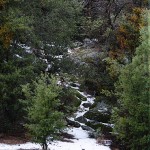
Photo by J.P. Crumrine
The third winter storm of 2014-15 brought less than an inch of rain to the Hill; however, some areas did see snow for a day. These rains have reduced the drought conditions from extreme to severe, according to the National Weather Service’s Drought Monitor website.
The U.S. Forest Service’s Keenwild Ranger Station recorded 0.42 inches and George Tate recorded 0.83 inches in Pine Cove. While the total rainfall, since the beginning of the rain year (July 1), at Keenwild is still below the long-term average through December, Pine Cove and Idyllwild have received more than the long-term average.
In Pine Cove, 11.7 inches have fallen through this week. The long-term average through the end of December is 9.22 inches. While more than 25 percent greater than the average, another 14 inches between now and June 30 is necessary to reach the annual average, which has occurred only twice since 2005.
Despite much discussion about climate change and its cause, the National Oceanic and Atmospheric Administration released a report on Dec. 8 which concluded, “The comparison of these three studies employing different methods and models found no substantial effect of human-induced climate change on the severe precipitation deficits over California.”
Weather researchers were unable to determine any long-term trend in the California weather. Nor did they find any conclusive evidence linking human-caused climate change to the current three-year drought and consequently attributed it to natural conditions.
An accompanying press release began with this statement, “According to a new NOAA-sponsored study, natural oceanic and atmospheric patterns are the primary drivers behind California’s ongoing drought. A high-pressure ridge off the West Coast (typical of historic droughts) prevailed for three winters, blocking important wet season storms, with ocean surface temperature patterns making such a ridge much more likely.”
For this winter, the report predicts wetter than normal weather, but no deluge of rain. “It is therefore reasonable to assume that precipitation amounts will very likely be greater than last winter, but not necessarily much above the climatological normal,” which is 25.67 inches of annual rain on the Hill.
While the NWS is forecasting a dry holiday period, its one-month and three-month forecasts predict above-average precipitation for Southern California.










